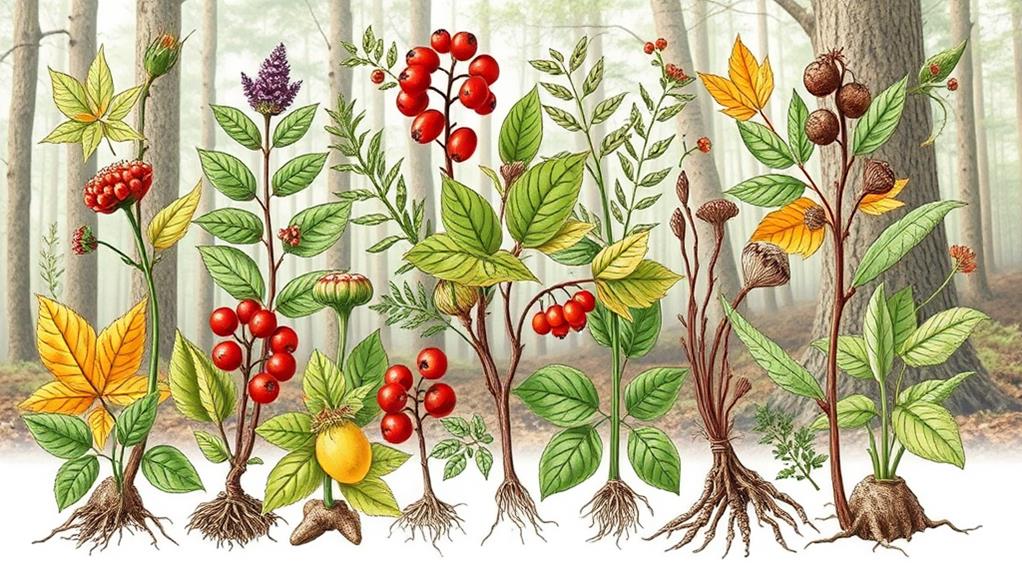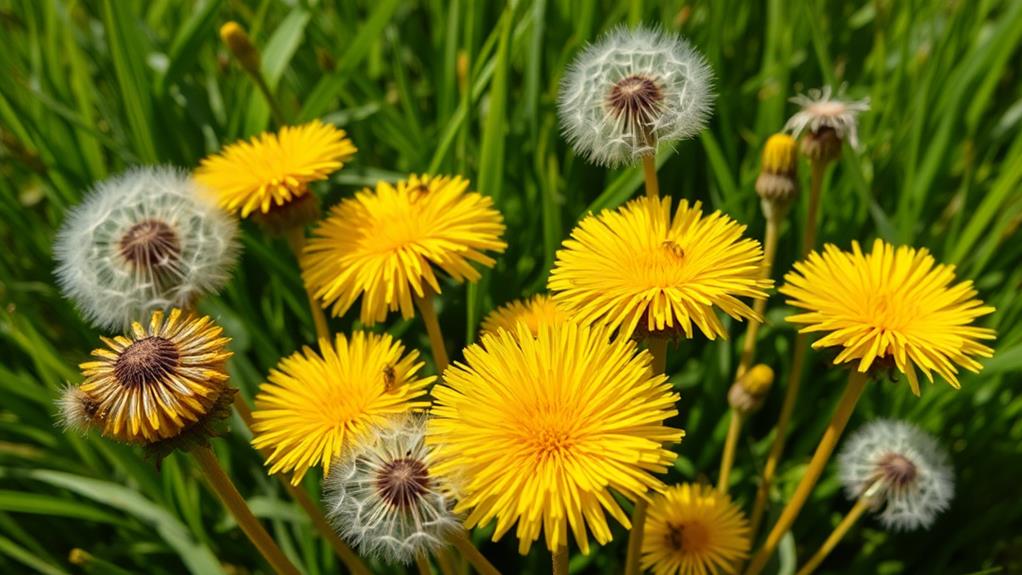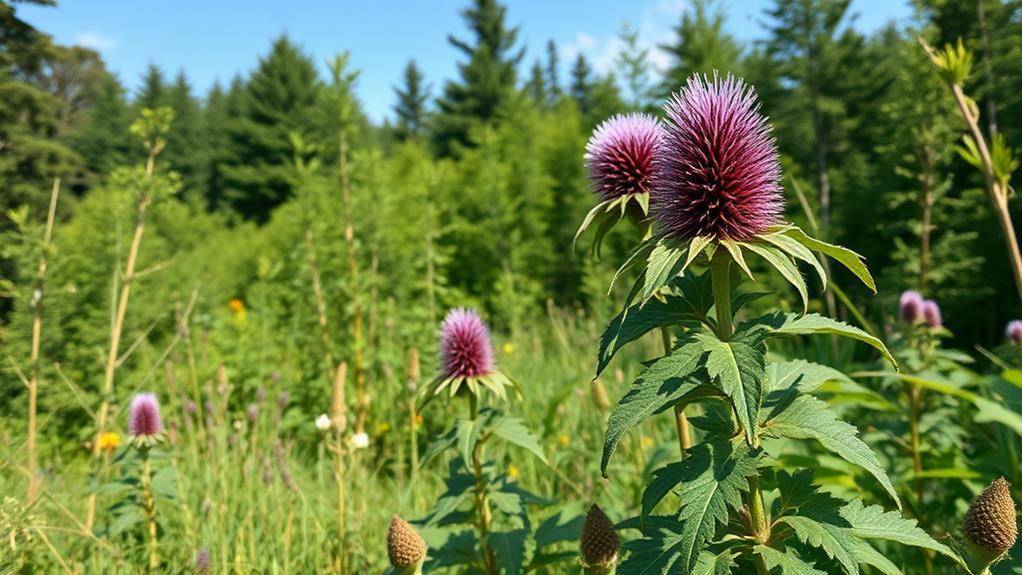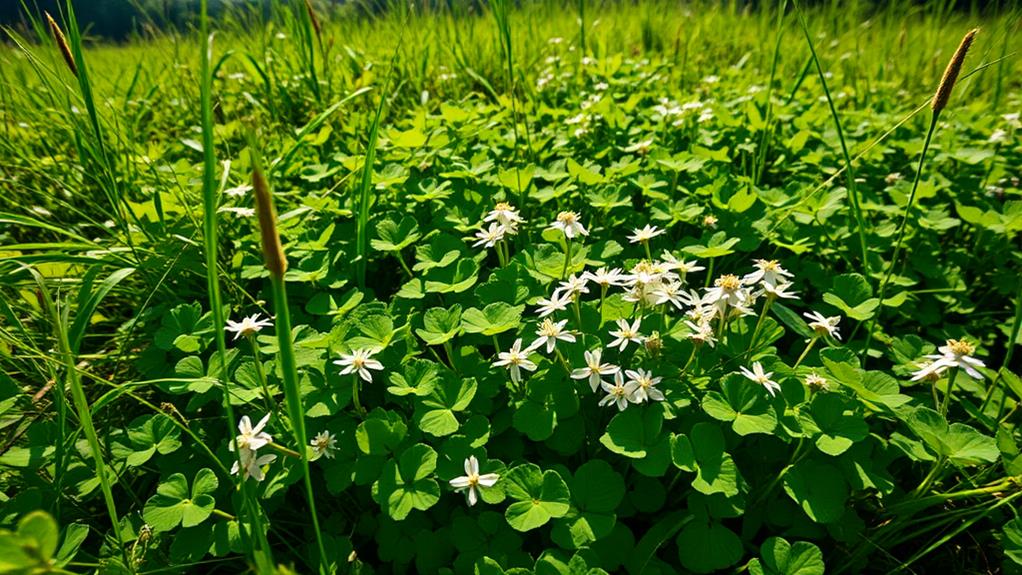
For survival, knowing the top 10 essential wild plants can be a lifesaver. Dandelions offer vitamins A, C, and K. Cattails provide starchy roots and fire-starting fluff. Burdock's roots are edible, and its leaves reduce inflammation. Plantain works as both food and medicine. Clover is edible and heals minor wounds. Chicory serves as a nutrient-rich food and coffee substitute. Pine needles make vitamin C-rich tea and great fire starters. Wild garlic fights infections and enhances flavor. Purslane is loaded with nutrients and omega-3s. Discover how these plants can be your best survival allies.
Dandelions

When you're in a survival situation, dandelions can be a crucial resource. You might overlook these common yellow flowers, but nearly every part of the plant is edible and nutritious. The leaves are packed with vitamins A, C, and K, as well as minerals like iron and calcium. They can be eaten raw in a salad or cooked to reduce their bitterness.
The roots of the dandelion are also valuable. You can roast and grind them to make a coffee substitute, which can be a morale booster when you're roughing it. Additionally, the roots contain inulin, a type of fiber that supports healthy digestion. Just make sure to clean them thoroughly to remove any dirt or contaminants.
Don't ignore the flowers either. They're high in antioxidants and can be used to make dandelion tea or even dandelion wine. The flowers can also be fried for a tasty treat.
In essence, dandelions provide a versatile, nutrient-rich food source that can help sustain you in the wild. So next time you see these seemingly inconspicuous plants, remember their potential to support your survival.
Cattails
Many people overlook cattails, but these tall, reed-like plants are a treasure trove of survival resources. You can find them in wetlands, marshes, and alongside ponds, making them accessible in various environments. Every part of the cattail is useful, from the roots to the tips.
Start by harvesting the roots, which are packed with starch. Clean them thoroughly and boil or roast them to make them edible. You can even grind them into flour for baking. The young shoots are tender and can be eaten raw or cooked, adding a nutritious crunch to your meals.
The brown, fluffy seed heads are excellent for starting fires. They catch a spark easily and burn long enough to ignite larger kindling. In addition, the leaves are strong and flexible, making them perfect for weaving mats, baskets, or even simple shelters.
Don't forget about the pollen. Harvest it in late spring by shaking the flower heads into a bag. It's rich in protein and can be used to supplement your diet.
Burdock

Burdock's large, heart-shaped leaves and distinctive burrs make it an easily recognizable plant in the wild. You can often find this hardy plant in fields, along roadsides, and at the edges of forests. The roots, leaves, and even the burrs of burdock offer various survival benefits.
First, burdock roots are a valuable food source. They're rich in starch and can be boiled or roasted to provide energy. You'll find that the roots have a slightly sweet, earthy flavor.
Second, the leaves can be used medicinally. They have anti-inflammatory properties and can be applied as a poultice to soothe burns, bites, and rashes. Simply crush the leaves and apply them directly to the affected area.
Lastly, the burrs have practical uses. They can be used to start fires because they're highly flammable when dry. Also, you can use them to make improvised fishing lures or to create rudimentary fasteners for clothing and gear.
| Part | Use |
|---|---|
| Roots | Edible, energy source |
| Leaves | Medicinal, anti-inflammatory |
| Burrs | Fire starter, fishing lure |
Plantain
Plantain is another essential wild plant you should know about for survival. This hardy plant is incredibly versatile and easy to identify. You'll often find plantain in disturbed areas like trails, lawns, and roadsides. Its broad, oval leaves are ribbed and grow in a rosette pattern close to the ground.
One of plantain's most valuable benefits is its medicinal use. If you get a cut, sting, or insect bite, you can quickly make a poultice by crushing the leaves and applying them directly to the affected area. The plant's natural anti-inflammatory and antimicrobial properties help reduce swelling and speed up healing.
Edibility is another major advantage. Both the young leaves and seeds are edible. You can eat the leaves raw in salads or cook them like spinach. The seeds can be ground into flour or added to soups and stews for extra nutrition.
Plantain is also rich in vitamins A, C, and K, as well as calcium and iron, making it a nutritious addition to your diet. So, next time you're in the wild, don't overlook this robust and beneficial plant.
Clover

Clover, with its distinctive trifoliate leaves, is another wild plant that's incredibly useful for survival. You'll often find it in fields, meadows, and lawns, making it easy to locate. Not only is clover edible, but it's also packed with nutrients like vitamins and minerals. You can eat the leaves, flowers, and even the seeds. They can be consumed raw or cooked, adding a slightly sweet flavor to your meals.
Here's a quick guide to clover's benefits:
| Benefit | Details |
|---|---|
| Nutritional Value | Rich in vitamins A, B, and C, plus minerals |
| Edibility | Leaves, flowers, and seeds are all edible |
| Medicinal Uses | Anti-inflammatory and blood-purifying |
| Availability | Commonly found in various environments |
Clover can also serve medicinal purposes. It has anti-inflammatory properties, making it useful for treating minor wounds and infections. To use it medicinally, you can make a poultice from the leaves or brew a tea from the flowers.
Given its high availability and nutritional benefits, clover is an excellent plant to recognize and utilize in the wild. So next time you're out foraging, don't overlook this small but mighty plant. It could be the key to sustaining your health and well-being in a survival situation.
Amaranth
Amaranth is a powerhouse wild plant that you shouldn't overlook in a survival scenario. This resilient plant is packed with nutrients and can be found in many environments, making it incredibly valuable when resources are scarce. You can identify amaranth by its broad, green leaves and clusters of small, reddish flowers.
One of the best things about amaranth is its versatility. Both the leaves and seeds are edible. The leaves are rich in vitamins A and C, iron, and calcium, and can be eaten raw or cooked. They're perfect for boosting your nutrient intake when other food sources are limited. The seeds, which are often called "pseudo-grains," are high in protein and can be boiled or ground into flour.
Harvesting amaranth is straightforward. Simply pluck the leaves as needed, but be sure to leave some behind so the plant can continue to grow. For the seeds, wait until the flower clusters turn brown and dry out. Shake the clusters over a container to collect the tiny seeds.
Incorporating amaranth into your diet during a survival situation can provide essential nutrients and energy, helping you stay strong and healthy.
Chicory

Another invaluable wild plant to recognize in a survival scenario is chicory. You can easily spot this versatile plant by its bright blue flowers and jagged leaves. Chicory is a powerhouse for survival due to its edible roots, leaves, and flowers. You can roast the roots to make a coffee substitute, which is especially helpful if you need a caffeine-like boost. The leaves can be eaten raw or cooked, providing essential nutrients like vitamin A and C. In addition, the flowers can be used to add a splash of flavor and nutrition to your meals, making chicory a true multi-purpose resource. Its abundance in the wild and its versatility make it a must-know for anyone looking to build the ultimate emergency survival kit. Not only does it provide sustenance, but its resilience and ease of identification make it a reliable ally in uncertain situations.
| Part of Plant | How to Use | Benefits |
|---|---|---|
| Roots | Roast and brew | Coffee substitute, energy |
| Leaves | Eat raw or cooked | Vitamins A, C, and minerals |
| Flowers | Add to salads | Aesthetic, nutritional value |
| Whole Plant | Forage and identify | Survival food source |
| Roots | Dry and grind | Flour alternative |
Chicory also has medicinal uses. You can use the roots to help with digestive issues, acting as a natural prebiotic. Plus, it's known for its anti-inflammatory properties. When foraging, always verify you're correctly identifying chicory to avoid any toxic look-alikes. Make this plant a part of your survival toolkit and you'll have a reliable source of nutrition and energy in the wild.
Pine Needles
When you're in a survival situation, pine needles are a fantastic resource you shouldn't overlook. Rich in vitamin C, they can boost your immune system and ward off scurvy. Simply steep a handful of fresh pine needles in hot water for about ten minutes to make a nourishing tea. This tea not only provides essential nutrients but also has a revitalizing taste that can lift your spirits.
Pine needles are also excellent fire starters. Their dry, resinous nature makes them catch fire quickly and burn well, which is vital when you need warmth or a way to cook food. Gather a bundle, and you'll have a reliable tinder source ready to ignite.
Moreover, pine needles can be used for bedding. They're soft, insulating, and can help create a comfortable sleeping surface that keeps you off the cold ground. Pile them up in a thick layer, and you'll have a natural mattress to rest on.
Wild Garlic

Wild garlic is a versatile and powerful plant you should definitely know about in any survival scenario. Not only is it abundant in many forests and woodlands, but it's also packed with essential nutrients and has medicinal properties. You can identify wild garlic by its broad, lance-shaped leaves and the distinctive garlic smell when crushed.
When you find wild garlic, you can use both the leaves and bulbs. The leaves are great for adding flavor to soups, stews, or even as a fresh salad ingredient. They're rich in vitamins A and C, which are vital for maintaining your health when food resources are limited. The bulbs, although smaller than cultivated garlic, can be used in similar ways and provide a similar nutritional benefit.
Medicinally, wild garlic has antibacterial and antiviral properties, making it useful for treating minor wounds and infections. You can crush the leaves to create a poultice or infuse them into boiling water to make a medicinal tea. This tea can help with digestion and respiratory issues.
Remember to forage responsibly, taking only what you need and ensuring the plant continues to thrive for future use. Wild garlic is a true survival ally.
Purslane
Just as wild garlic offers a wealth of benefits, purslane is another wild plant that should be on your radar for survival situations. You'll find it growing in many parts of the world, often in disturbed soils like gardens and roadsides. This hardy plant is packed with nutrients, making it a valuable resource when food is scarce.
Purslane is not only edible but also incredibly nutritious. It's a rich source of omega-3 fatty acids, which are essential for your heart and brain health. Additionally, it provides:
- Vitamins A, C, and E: These vitamins are essential for maintaining your immune system.
- Minerals: Purslane is loaded with magnesium, calcium, potassium, and iron.
- Antioxidants: These help combat oxidative stress and support overall health.
- Water content: High water content helps keep you hydrated, which is indispensable in survival scenarios.
You can eat purslane raw in salads or cook it as a green vegetable. Its slightly tangy, lemony flavor adds a rejuvenating touch to your meals. So, next time you're in a survival situation, keep an eye out for purslane. It's a small plant that can make a big difference in your well-being.
At a Glance
In a survival scenario, these wild plants can be your lifeline, much like how the humble hobbits depended on their foraged food in Middle-earth. You've got the knowledge now: from dandelions to wild garlic, nature's pantry is stocked and ready. Remember, with a bit of awareness and respect for the environment, you can thrive in the wild. So, embrace your inner adventurer and let these plants guide you through your own epic journey.






